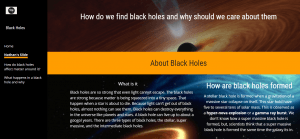

Hi! This is the last post for Brian Shin and Michael Alford. We have two previous posts, the last one can be found here.
Our students in gr.6 had just come up with their inquiry questions and were excited to delve deep.
This leads us to the Gather phase.
At this point a research rubric was introduced, outlining how many words and the type of visuals that should be included; also, to describe problems with researching their question in relation to scientific inquiry (for example, the distances of our universe makes inquiry more difficult); and to formulate a new “I Wonder” question manifested from their research that promotes further inquiry (but won’t be answered).
The boys now began their focused research to answer their Inquiry. They had to use a mix of sources including the cart of books, youtube videos, online websites, and podcasts. What they were to create with their research findings was left a mystery…
Impressions: Multiple reminders were absolutely necessary in addition to the initial review of the research rubric. You know 11 year old boys – once they get going it is as if they grow ‘blinders’! Teacher feedback in the form of check-ins at an individual level was helpful. However, we needed to keep in mind that Inquiry should avoid continuous ‘hand-holding’. A certain amount of autonomy fosters ownership and accountability.
A few classes were given to finish their research, and with their findings they were introduced to the next phase: Create.
Themed topics were announced and posted on the walls of the classroom. Some themes were: Black holes and dark matter, Space technology, Stars & Nebulae, Planet colonization including travel…etc..
The students then moved to the posted themes according to their own inquiry topic and groups were formed. If one grouping was too large then it would be split up.
Two options were outlined to the groupings for what they had to ‘create’:
Impressions: Creating a website seemed to be the harder choice. They could use Wix, Weebly, or Google Sites. Some groups started to design a website but decided to switch to infographics after a period because of website creation difficulties. The infographics looked wonderful displayed together but due to time constraint creative license was limited. Ultimately, the inquiry process provided students with a learning tool that allowed for the generation of focused questions and deeper understanding. Bonus: this was all about their unique individual interests!

Pictochart or Canva infographics

Part of a website presentation
Some student inquiry questions are shown again below, but with their new ‘I wonder’ question to promote further inquiry for another time…
“Why can time slow down when you near a black hole?” – “I wonder how astronomers can test Einstein’s General Theory of Relativity?”
“How can we use the gravitational pull of a black hole to our advantage when travelling through space?” – “I wonder if the mass or size of a black hole affects the penrose process?”
“What is the process that creates energy for stars and how might humans use it as an energy source?” – “I wonder if nuclear fusion will ever be a main energy source for humans?”
“How might we create new space technology that is more advanced and doesn’t need fuel?” – “I wonder why fuel is one of the only things we have figured out to use that generates enough force to leave earth?”
“How can the nano craft of the project ‘Breakthrough Starshot’ withstand a force of 10,000 g’s?” – “I wonder how will the starshot company predict where exactly Proxima B will be in 20 years?”
“Why can’t we see dark matter? – “I wonder why the universe is predicted to collapse on itself?”
The Share phase
Our intention was for a gallery walk/show & tell, but alas time ran out. Therefore we have come up with our own “I wonder” question about this process: “We wonder how can students present a succinct, meaningful ‘take away’ regarding the entire process and what they learned?”
Thank you for reading our posts! We hope you gleaned some idea(s) from them. Good luck with your GID project!
Hi Brian and Michael,
Thank you for sharing your experiences with us! What a great week on the blog. Your beautiful posts created a clear image of the entire process through your reports on what you did and details about how you did it at each phase. The use of Inquiry Tools and understanding of the intention of each phase was clearly represented, (which makes me smile)!
Your reflective thinking throughout is so helpful as were the rich student examples. Your final wonder question is a good one. I’m thinking that you might want to add, in that final Evaluate phase a summarizing protocol or way to help the students come up with that succinct ‘take away’. That would be a good exercise in language, vocabulary, and critical thinking. Perhaps, it could be part of the Language or English section of the course? Students might need support to accomplish that, but I agree that it would be a worth while endeavor.
This was a wonderful example of use of the model for all science teachers out there! I see how much the students learned about all kinds of aspects of space through their personalized questions and interests. It’s not easy to ‘let them go’ but it seems like it was worth it.
Thank you so much for sharing your expertise with us! I so enjoy working with you all.
Best wishes for a wonderful summer!
Leslie Maniotes,PhD
Author of the GID series